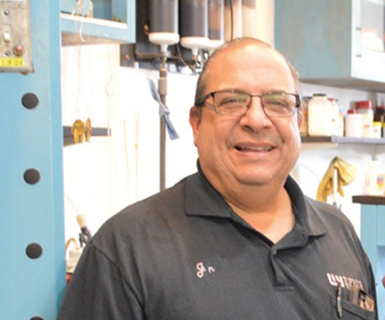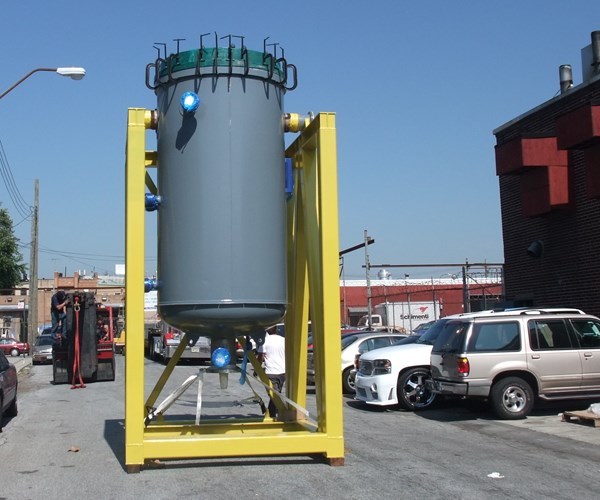
Stephen Candiloro Jr.

It all started about ten years ago. I was sitting in my office after hours when the phone rang and the person on the line, calling from Missoula, Montana, asked if we could plate the inside of a water-cooled, stainless steel bell jar? I envisioned he was talking about a typical laboratory bell jar. Open at one end with a dome shaped closure at the other. Usually about a foot in diameter and 2 feet high. I asked, “How big is it?” He replied, “13 feet high, 7 feet in diameter and it weighs about 40,000 pounds. And oh yes, we need 100 of them done.”When I got up off the floor, I asked him how many plating companies he had approached with this project. He said he had been all over the world trying to find a shop that would even discuss it, much less agree to do it. I said, “I think we might have a shot at it but the non-recurring cost would be enormous.” I threw out a million and a half bucks for NRE to see if he was real. Indeed, he was. I knew JR had experience with the smaller jar that I had originally envisioned. He would make the bell jar its own plating tank. After inserting an anode, we would repeatedly fill and drain it with each solution in the process, just like a washing machine. When I laid out the project to JR, his reaction was just what I expected. “Let me at it,” he exclaimed, and a day later he presented me with his plan of action.He had designed a steel gantry-like stand that would support the jar by its trunnion “ears” and then the stand and jar would be transported by a forklift with 50,000-pound capacity into the loading dock area of our building. Preparation for that required moving our entire wastewater treatment system onto the plating shop floor with re-plumbing every rinse tank as well as removing part of the building to accommodate the height of the jar in the stand.Another huge up-front cost was the gold plating solution — more than 2,000 gallons valued at over $4 million would be needed to fill the jar. JR designed what we laughingly called a “giant fiberglass condom,” which he had fabricated at a local boat builder. This plug would displace about half that volume as well as offer a mounting surface for the nickel and platinum-coated titanium anodes, as well as some 250 spray nozzles to thoroughly rinse both the jar and the surface of the plug between each process solution to prevent cross-contaminating the next solution in the plating sequence.That still left us with a gold inventory requirement over $2 million, which was required to fill the one-foot gap between the plug and the wall of the jar. The customer did not balk at paying these up-front costs as well as the six-figure price I quoted for each bell jar. In a short time, JR and his team had gotten production up to one jar a day until 103 were shipped!
“Working so closely with JR these past few years was an incredible honor for me. From decades past, I was aware of the depth of technical talent JR possessed. During the last several years I worked shoulder-to-shoulder with JR, I really got a sense for who JR was as a person and what he stood for. I am very grateful for that experience.”
Related Content
Innovation in Plating on Plastic
Plating on advanced plastics solution offers improved adhesion, temperature resistance and cost savings.
Read MoreProducts Finishing Reveals 2023 Qualifying Top Shops
Each year PF conducts its Top Shops Benchmarking Survey, offering shops a tool to better understand their overall performance in the industry. The program also recognizes shops that meet a set of criteria to qualify as Top Shops.
Read MorePossibilities From Electroplating 3D Printed Plastic Parts
Adding layers of nickel or copper to 3D printed polymer can impart desired properties such as electrical conductivity, EMI shielding, abrasion resistance and improved strength — approaching and even exceeding 3D printed metal, according to RePliForm.
Read MoreAdvantages to Pumped Eductor Agitation
Not all agitation methods are created equally. Pumped agitation with eductor nozzles can improve process tanks and quickly show a reduction in operating costs while keeping staff safe, following environmental legislation and preventing pollution.
Read MoreRead Next
Episode 45: An Interview with Chandler Mancuso, MacDermid Envio Solutions
Chandler Mancuso, technical director with MacDermid Envio discusses updating your wastewater treatment system and implementing materials recycling solutions to increase efficiencies, control costs and reduce environmental impact.
Read MoreEducation Bringing Cleaning to Machining
Debuting new speakers and cleaning technology content during this half-day workshop co-located with IMTS 2024.
Read MoreDelivering Increased Benefits to Greenhouse Films
Baystar's Borstar technology is helping customers deliver better, more reliable production methods to greenhouse agriculture.
Read More













.jpg;maxWidth=300;quality=90)







